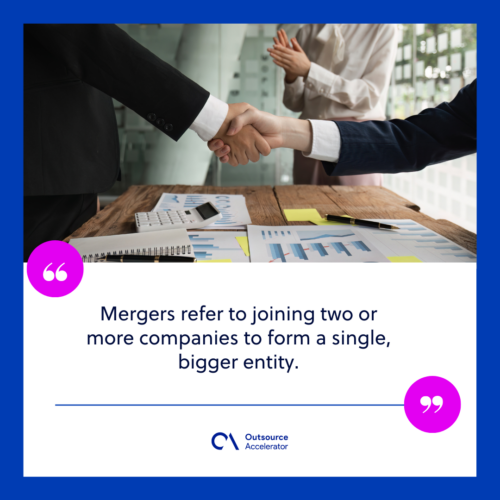Understanding mergers and acquisitions

Mergers and acquisitions (M&A) have become common strategies for companies aiming to expand, gain market share, or enhance their competitive advantage.
Most known enterprises nowadays, including Google (Alphabet), found success in merging and acquiring other firms one way or another.
While global M&A has seen a plunge this year, investors are still optimistic about market recovery in the future.
But what exactly are mergers and acquisitions? This article will delve into the world of mergers and acquisitions.
What are mergers?
Mergers refer to joining two or more companies to form a single, bigger entity.
In a merger, two businesses combine their assets, liabilities, resources, and operations to create a new firm. However, for a merger to happen, each company should be equal in size, customer base, and operational scale.
Mergers are sometimes called “mergers of equals.”
The merger process involves due diligence, negotiations, shareholder approval, and regulatory scrutiny.
If successful, a merger can result in a stronger, more competitive entity. Meanwhile, challenges may arise in terms of cultural integration, management alignment, and achieving the anticipated synergies.

What are acquisitions?
On the other hand, acquisitions involve one company purchasing another, resulting in the acquiring company obtaining full control over the acquired entity.
Compared to mergers, acquisitions are done when a larger firm acquires a small business. The small business undergoes a no-shop clause while the process is ongoing.
Afterward, the acquiring company takes over the ownership, assets, and liabilities of the target company. This enables them to expand their market presence, acquire intellectual property, or eliminate competition.
Acquisitions may take a friendly approach to buying a company. However, a hostile takeover may still happen depending on the approval of the bigger company’s board of directors.
Mergers and acquisitions: Key differences
While mergers and acquisitions share some similarities, there are crucial differences between the two.
In a merger, two or more companies voluntarily agree to combine their operations and create a new entity. These entities are usually made up of firms with equal assets, shares, customer base, and other aspects.
In contrast, acquisitions can be friendly or hostile, with the acquiring company taking control without the approval of the target company.
Additionally, the resulting entity in a merger can be called a “group of companies,” with shared ownership and management control. Each firm forming the group can become a subsidiary of the parent company or maintain its operations and identity before the merger.
In an acquisition, the acquiring company retains ownership and control over the target company. They may continue operating as a subsidiary with its patents and operations being controlled by the main firm.
Purpose of mergers and acquisitions
Mergers and acquisitions serve various purposes, depending on the goals and objectives of the companies involved.
Some common aims include:
- Growth and expansion: Merger and acquisition activities allow companies to expand into new markets, increase their customer base, or diversify their product offerings.
- Trying new ventures: Businesses looking to venture into new industries can benefit from M&A by acquiring smaller firms from the industries they want to enter.
- Synergy and efficiency: By combining resources, expertise, and operations, mergers and acquisitions can generate synergies and improve operational efficiency. This move usually leads to increased competitiveness and efficiency.
- Market dominance: In some industry practices, mergers and acquisitions can be a strategic move to eliminate competition or strengthen market positioning. This allows firms to gain a larger market share or establish themselves as industry leaders.
- Access to resources: Acquiring companies may seek to gain access to new technologies, intellectual property, distribution networks, or talented workforce through M&A transactions.
- Strategic restructuring: Mergers and acquisitions can help companies restructure their operations, streamline processes, or divest non-core assets to focus on their core competencies.

How do mergers and acquisitions work?
Mergers and acquisitions involve a series of complex processes and considerations. Each consists of five phases, namely:
Preliminary assessment
Companies must first identify suitable targets or merger partners. It usually starts with organizations equal to or smaller than the firm, checking their performance and other aspects that a merger or acquisition can improve.
Negotiation and intent
Once identified, the parent company must then negotiate its intent in M&A through a letter of intent. The board of directors for each firm will negotiate the terms and conditions and secure regulatory approvals for the merger.
The intent may be announced publicly through media releases or done on closed doors at first.
Due diligence
During the due diligence phase, companies thoroughly examine the financials, operations, risks, and legal aspects of the target company. Depending on the parent firm’s preference, they may look at their target’s enterprise architecture at large.
This evaluation helps the acquiring company assess the value and compatibility of the target and identify any potential challenges or synergies.
Due diligence usually starts with gathering ample information about the company and ends with projecting its future. Some teams formulate a checklist in their due diligence process for their target firms.
Closing
Negotiating the terms of the merger or acquisition terms involves discussions on valuation, purchase price, payment methods, management structure, and other relevant details.
Once an agreement is reached, legal documentation is drafted, and regulatory approvals are sought, ensuring compliance with applicable laws and regulations.
Pre-closure implementation
After the completion of the transaction, successful integration becomes crucial.
Integration involves aligning processes, systems, cultures, and people to ensure a smooth transition and maximize the synergistic benefits of the merger or acquisition.
Types of mergers and acquisitions
One type of merger mentioned earlier is the subsidiary or reverse triangular merger.
Here, each subsidiary aligns with the parent company’s values, culture, and regulations while maintaining autonomy in its operations.
Mergers and acquisitions can take various forms, each with its own strategic implications. Other common types include:
Market extension
In a market extension merger or acquisition, a company aims to expand its reach into new geographic markets.
Acquiring or merging with an established firm in the target market provides the acquiring company instant access to:
- New customer base
- Distribution channels
- Local expertise
Conglomerate
Conglomerate mergers, also known as conglomerates, involve the combination of companies operating in unrelated industries.
This type of M&A allows diversification across different sectors, reducing risks associated with economic fluctuations in any single industry. Conglomerate mergers can also leverage shared resources and cross-selling opportunities.
Reverse merger
A reverse merger should not be confused with subsidiaries or reverse triangular mergers.
This type occurs when a private company merges with a public company. The private company becomes publicly traded without needing an initial public offering (IPO).
This type of merger allows private companies to go public quickly and gain access to public capital markets.
Consolidation
Consolidation refers to the merger or acquisition of companies within the same industry. By combining operations, companies can eliminate duplicate processes, reduce competition, and achieve economies of scale.
Consolidation can lead to increased market power and enhanced bargaining power with suppliers.
Tips for undergoing mergers and acquisitions
Mergers and acquisitions are strategic business transactions that can shape the future of companies.
Understanding their intricacies, purpose, and different types is essential for businesses considering such endeavors.
Undergoing a merger or acquisition can be a complex and challenging process. Here are some valuable tips to consider:
- Thorough planning: Develop a comprehensive M&A strategy and align it with your company’s overall goals and objectives. Clearly define the purpose, identify potential targets, and anticipate challenges to mitigate risks.
- Due diligence: Conduct rigorous due diligence on the target company to evaluate its financial health, operations, legal standing, and potential synergies.
- Clear communication: Maintain clear and transparent communication with all stakeholders, including employees, customers, suppliers, and investors, throughout the M&A process.
- Leadership cohesion: Ensure that leadership teams from both sides are aligned in their vision and goals. A cohesive leadership front can provide stability during times of change and facilitate a smoother transition for employees at all levels.
- Talent retention strategies: Develop strategies to retain key talent from both organizations. Provide career development opportunities to maintain a motivated and skilled workforce.
- Clear roadmap: Establish a clear and detailed integration roadmap. This includes a timeline, milestones, and specific tasks. A well-defined plan helps teams stay focused, minimizes disruptions, and ensures a more organized merger process.
- Legal and regulatory compliance: Navigate the legal and regulatory landscape diligently. Adhering to compliance requirements and seeking legal counsel when necessary helps avoid potential setbacks and ensures a smooth approval process.
- Technology integration: Harmonize technology systems to streamline operations. Ensuring that the technological infrastructure of both entities is compatible facilitates a more efficient and integrated workflow.
- Cultural alignment: Pay close attention to cultural compatibility between the merging companies. Successful integration requires shared values, open communication, and a commitment to harmonize organizational cultures.
- Post-merger integration: Develop a detailed integration plan and implement it effectively to maximize the synergistic benefits of the merger or acquisition.

Through these practices, companies can confidently navigate the complexities of M&A transactions.
Further, this can help them increase their chances of achieving desired outcomes and capitalizing on the opportunities presented by these strategic moves.







 Independent
Independent




